| Update as of September 18, 2023:
If you’re a high school or grade school student in the Philippines who’s joining the photojournalism contest in the division, regional, or national press conference, I’m offering two free resources to you : A. 900-plus interactive exercises on English grammar, vocabulary, reading comprehension, verbal analogy, etc (with around 200 megabytes total file size). The exercises have time limit and automatic scoring, with an average of 10 items per exercise. Examples of these interactive exercises are: Common English grammar errors: Exercise 01 (nouns - confusions of number); Phrasal Verbs: Expressions with Go; English Placement Test (45 items). B. 200-plus resources (JPG, PDF, MP4, etc.) on photography and photojournalism, with 600-plus megabytes total file size. For some examples of these resources, surf to the “Free photography e-books, cheat sheets” page. For the download links and more information about how to use the interactive exercises, please surf to my “Better English resources and exercises” blog. Please inform your journalism teacher/schoolpaper adviser or your parents about these resources before downloading them. If you have any question about downloading or using these free resources, please email me (after informing your journalism teacher/schoolpaper adviser or your parents). I’ll be able to reply to you within two to three days; if you don’t see my reply in your Inbox, check your Spam folder. Or, you can text me. Also, if you win in the photojournalism contest at whatever level (district, division, regional, or national), you can send me your prizewinning pictures, and I will feature them in a blog post. Atty. Gerry T. Galacio gtgalacio@yahoo.com 0927-798-3138 |
 Lines are the most basic component of a photographic image, and can be classified into two ways - physical lines, and imaginary lines of force and direction.
Lines are the most basic component of a photographic image, and can be classified into two ways - physical lines, and imaginary lines of force and direction.Physical lines
These lines are those that exist in the empirical world like painted lines on the streets or on the basketball court, the lines on a piece of paper and the bare branches of a tree suffering under summer’s merciless sun ... I know, I know, it’s such a corny line!
Imaginary lines of force and direction
This kind of lines exists only in our minds like the rows of CAT cadets in a fancy drill competition below, the direction in which persons look, like these guys and girls all looking at the little girl with the pig tails at the extreme left, the dancers looking towards to the right; the direction in which moving objects travel, the imaginary lines created when we divide something up like a very real, very delicious pizza..
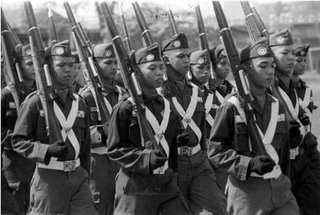
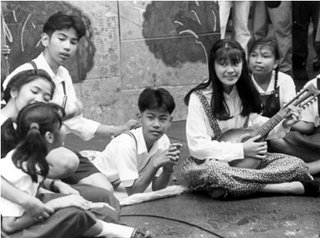
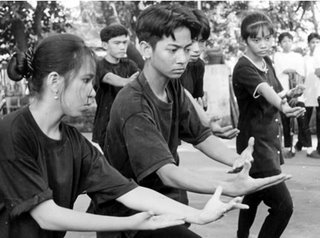 (Please take note that the pictures I will be posting to illustrate this series on photojournalism are more than a decade old, and thus leave a lot to be desired in terms of quality. I shot all these pictures using my Canon AE-1 Program camera and mostly Kodak Tri-X film. This film is reportedly the favorite of Sebastiao Salgado, considered as the world’s best photojournalist.)
(Please take note that the pictures I will be posting to illustrate this series on photojournalism are more than a decade old, and thus leave a lot to be desired in terms of quality. I shot all these pictures using my Canon AE-1 Program camera and mostly Kodak Tri-X film. This film is reportedly the favorite of Sebastiao Salgado, considered as the world’s best photojournalist.)Psychological effects of lines
Lines have profound psychological effects on the viewers; for example, pictures containing horizontal lines evoke feelings of serenity, stability, while vertical lines have a sense of energy, grandeur. Diagonal lines, like those in the picture of the marching cadets above (the crossbands on their uniforms, their rifles, their left legs thrusting forward in cadence) express movement and dynamism.
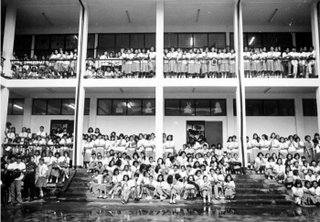 Element of shape
Element of shapeLines when joined together create two-dimensional shapes like circles, squares, triangles, rectangles, polygons, etc. Shapes attract our attention first and foremost whenever we look at photographs. Everyday objects are rich sources of shapes; some shapes will be obvious like the painted circle in the middle of the gymnasium below, and the water hose (very first picture above).
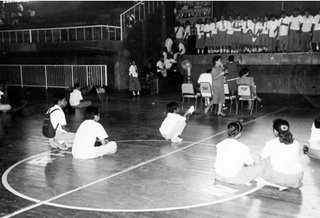 Photography and pizza
Photography and pizzaTim Burton is the world famous director of such movies as “Edward Scissorhands”, “Beetlejuice,” and “Batman” parts 1 and 2. One time, while he was doing post-production work on the Batman 2 movie, he got hungry so he ordered out for some pizza. He got a mild surprise when upon opening the box, he found several pictures on top of the pizza.
The pizza delivery guy, named John Pezzota if I remember right, was a struggling photographer working part time at a pizza joint to support himself. When he found out that it was Tim Burton who was ordering the pizza, he took a chance by placing some of his black and white pictures in the pizza box.
Well, Tim Burton did like the pizza, and the photographer’s dark somber style which suited Batman 2’s moody atmosphere. The result? The photographer got the job of shooting the movie posters of Batman played by Michael Keaton and Catwoman played by Michelle Pffeifer. Cowabunga!






